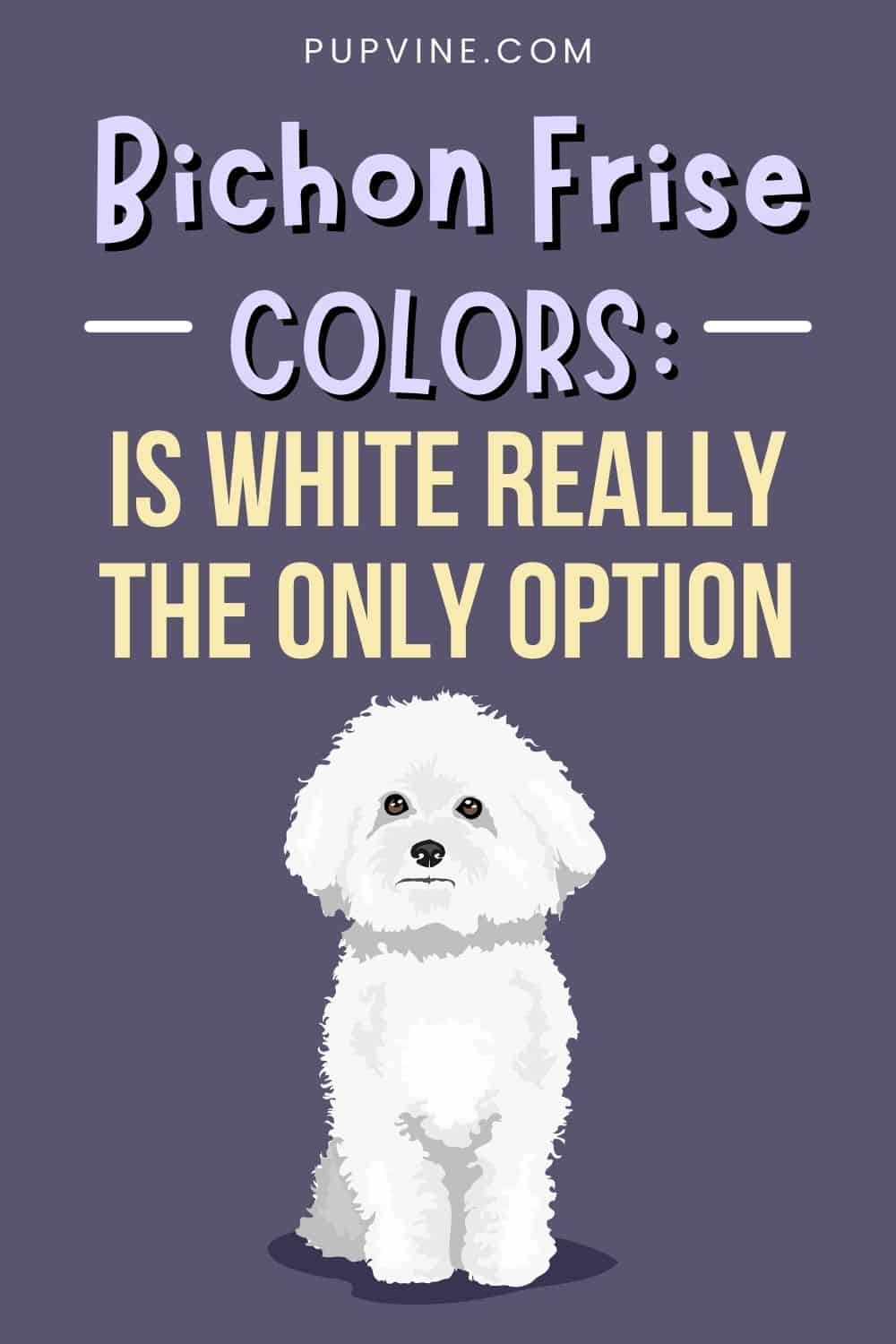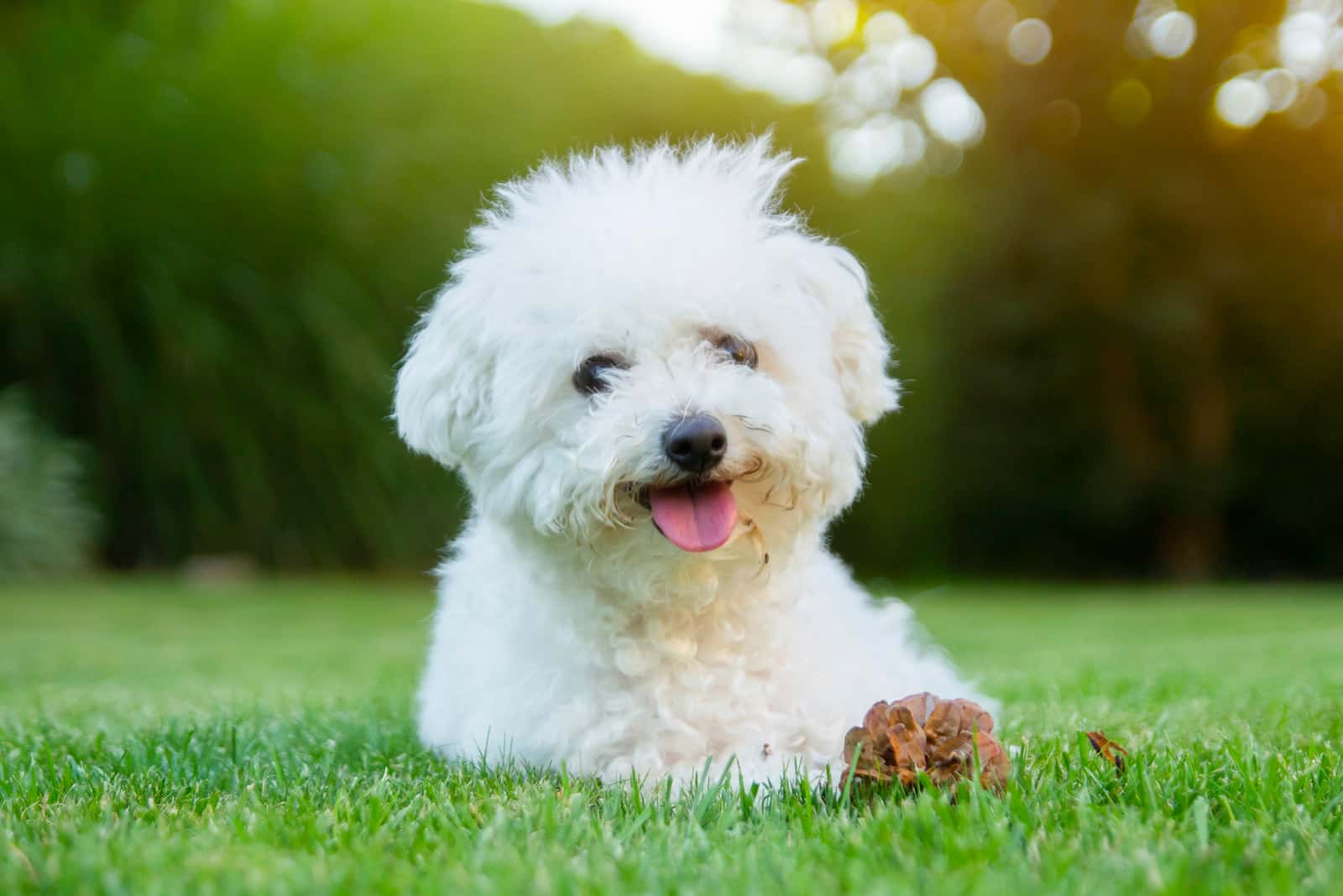There is a clear reason why everyone loves the Bichon Frise breed. They’re cute, they’re curly, and they’re just adorable!
These pups are known for their snow-white coats and black button noses. They are one of the most well-known purse dogs despite their personality not really matching that description. These are intelligent and loyal dogs that would love nothing else than to stay by your side while you’re going for a jog.
In fact, these dogs were loved centuries ago when they were considered perfect pets on Spanish, Italian, and French courts.
While these doggies are known for being a white dog breed, many people wonder: Are there more Bichon Frise colors, or do these dogs only come in white?
Well, believe it or not, there are as many as four acceptable Bichon Frise colors, but all of them are connected to the white color. If this sounds like something that would interest you, you’re in the right place.
We’ll talk more about Bichon Frise colors and answer some questions that dog lovers wonder about. Let’s get started!
About The Bichon Frise
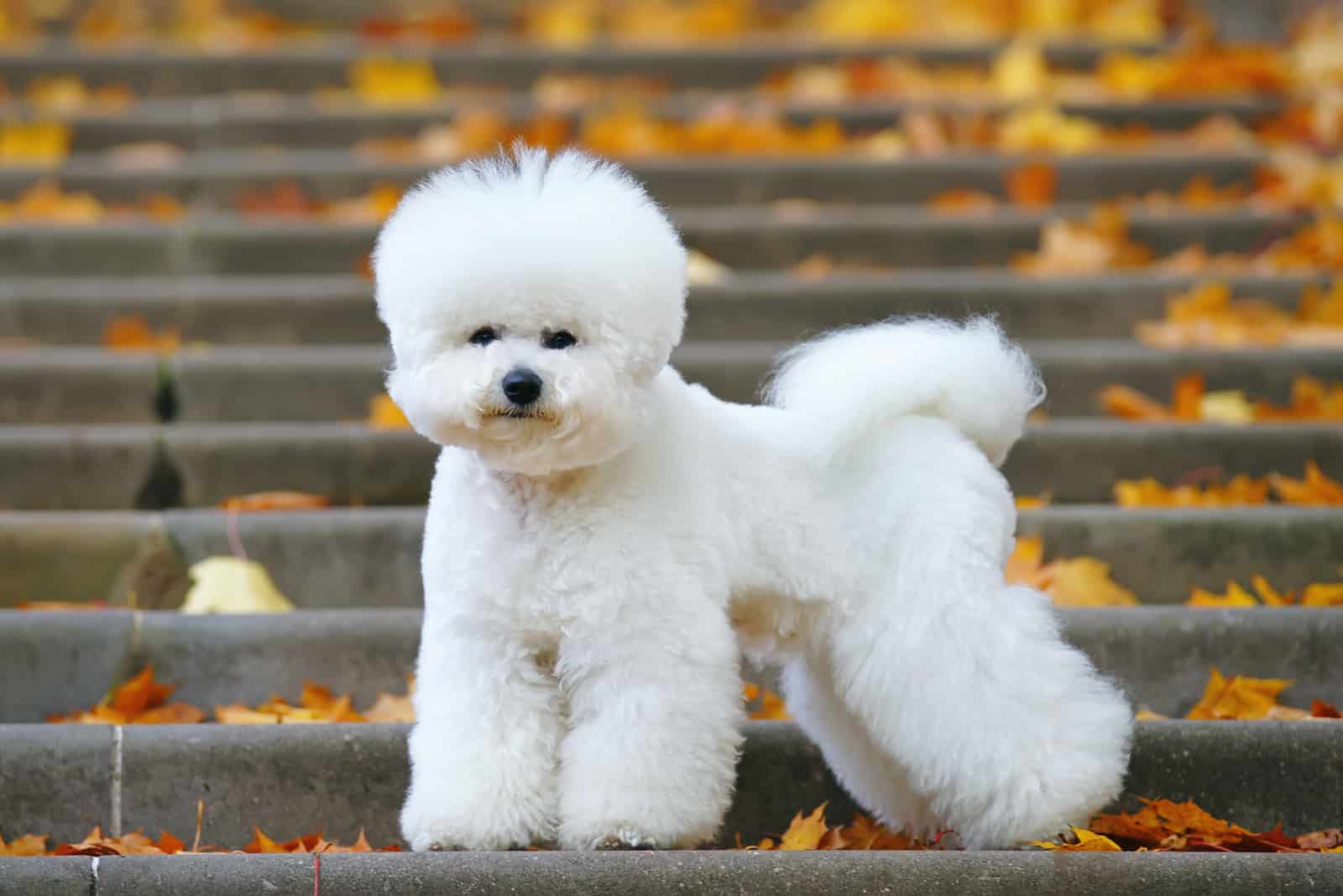
Bichon Frise, together with Havanese, Maltese, and Bolognese, belongs to the white dog group that is known as the Barbichon type. These little dogs originate from Tenerife, located on the Canary Islands in the Mediterranean. In fact, the ancestors of the Bichon Frise were known as Bichon Tenerife.
In the 13th and 14th centuries, these pups became favorites of European nobles, and they were kept in royal courts of France, Italy, and Spain as beloved lapdogs. In fact, even the Spanish painter, Francisco Goya, captured the gorgeous looks of these small dogs.
However, their life as royals ended with the French Revolution, and they were turned into circus dogs. They remained with the circus until the World Wars when they were abandoned once again.
Thankfully, a few fanciers helped save this small breed, which was registered with the Societe Centrale Canine in 1933. The breed was then known as the Bichon a Poil Frise – the curly-haired Bichon.
In 1964, the Bichon Frise Club of America was founded, and the breed was fully recognized by the American Kennel Club (AKC) in 1972.
According to the breed standard, these dogs are less than a foot tall, with a velvety, hypoallergenic coat, large dark eyes, and a black nose.
These pups make good watchdogs as they are barkers, but they are social dogs that will want to be best friends with everyone they meet – no matter if you’ve got a male or a female dog.
They are smart and confident, making them amazing city dogs. They are easy to train, and love performing tricks to amaze their family members. Overall, these are happy companion dogs with a long lifespan that will bring joy into everyone’s life.
What Colors Do The Bichon Frise Come In?
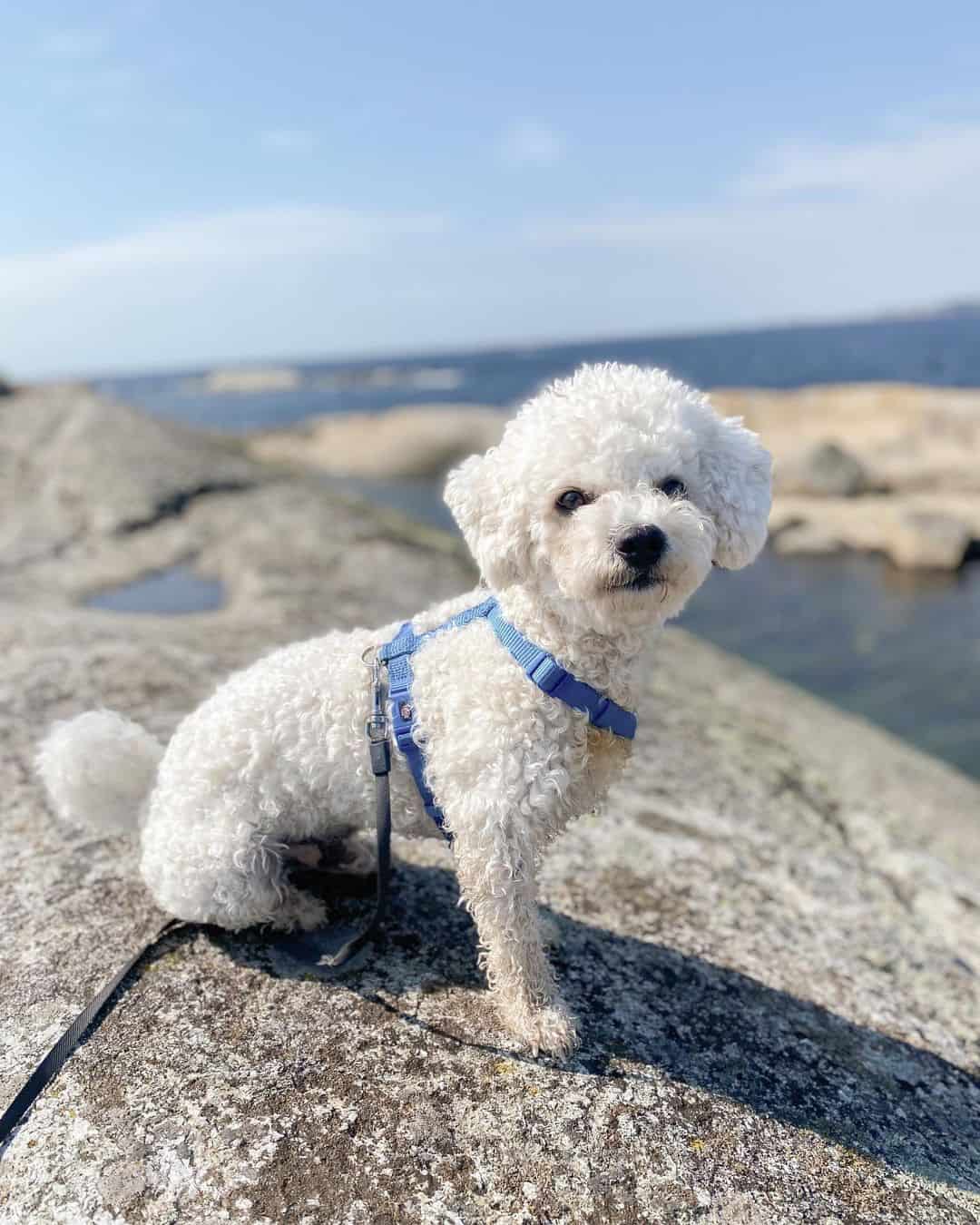
Photo from: @micothebichon
It is a common misconception that the Bichon Frise comes in just white. However, the AKC recognizes four Bichon Frise colors! These colors are:
• White
• White and apricot
• White and cream
• White and buff
Of course, the AKC isn’t the only kennel club that can determine the breed standard. According to the United Kennel Club (UKC) and the Canadian Kennel Club (CKC), these colors are the same.
However, the Federation Cynologique Internationale (FCI) only allows the white coat color – although it is allowed for puppies no older than one year to have some slightly beige tint on no more than 10% of their body.
We’ll go through each of these colors in great detail so you can know what they look like, and how to know if your Bichon Frise falls under the breed standard.
Bichon Frise Colors: White
If you try to look for photos of the Bichon Frise, you’ll see that most of these show an all-white dog. This is because solid white is the main Bichon Frise color, and the majority of the breed is white. In fact, white is the original color of the breed.
Let’s face it. When you think of this lap dog breed, you think of white, fluffy dogs. It’s no surprise that many people don’t know that Bichons can come in any other color.
In fact, other than the few allowed exceptions we’ll list under, a Bichon Frise shouldn’t have a single hair of darker color on its white coat.
While there’s no denying that white is the classiest color, it’s important to be aware that all white dogs can get dirty easily, especially after spending some time outdoors. These dogs need more baths than most other breeds, so be prepared for more maintenance.
All other acceptable Bichon Frise colors are simply considered to be a variation of a white Bichon.
Bichon Frise Colors: White and Apricot
The white and apricot Bichon Frise has a prevalent white base coat. However, he has patches of apricot color mostly around his ears, face, and a little on his body.
Apricot is a very gentle yellow-orange shade similar to the apricot fruit, but it’s a bit paler. It’s a subtle color that blends nicely with the white coat, giving the dog a unique and cute look.
Apricot isn’t a rare color in dogs. In fact, it can be found in many curly dog breeds, such as Poodles.
Keep in mind that only around 10% of your Bichon Frise’s coat can come in apricot. If it’s more than that, your pooch is likely mixed with a Poodle.
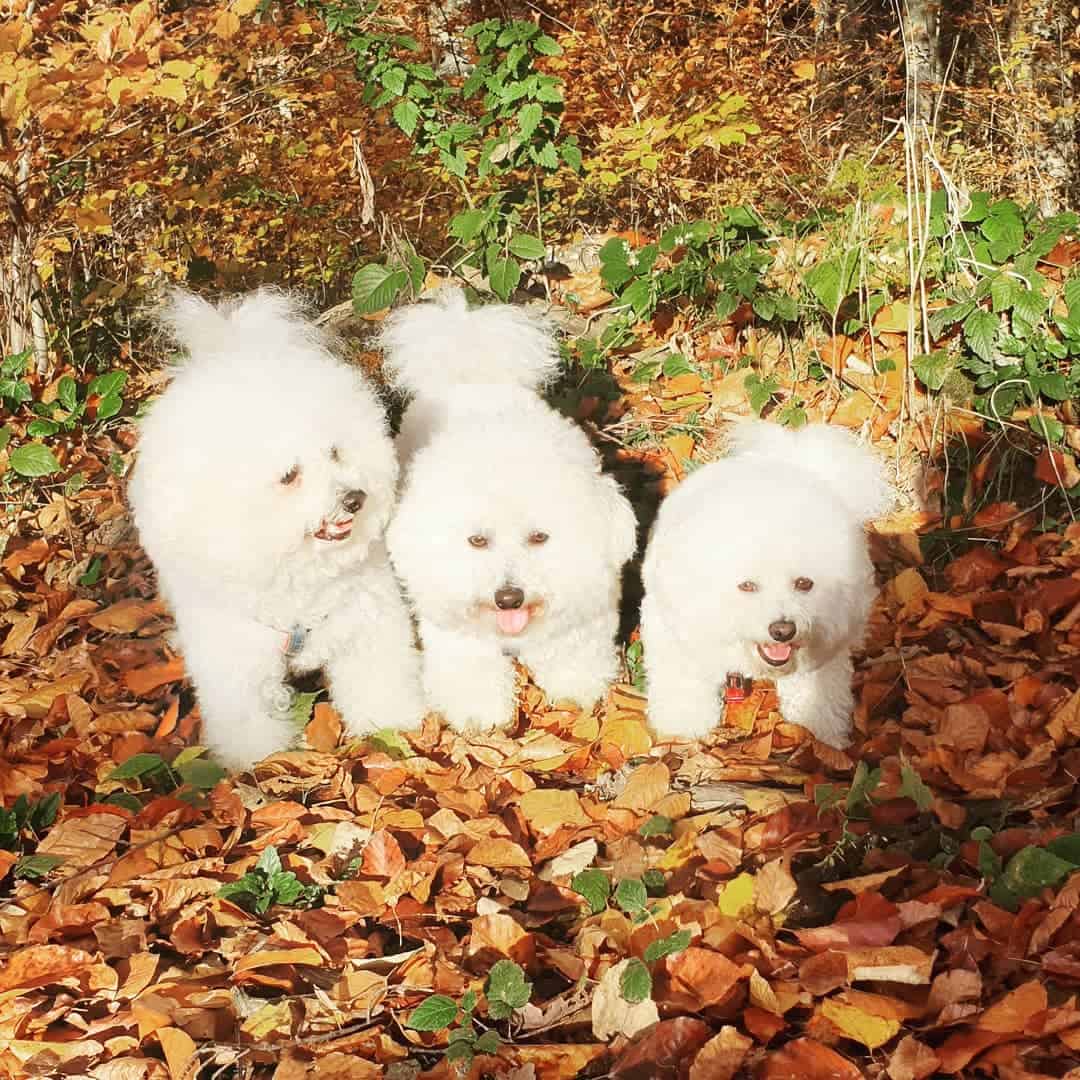
Photo from: @bichon_frise_family
Bichon Frise Colors: White and Cream
White and cream Bichons don’t really have a specific gene for that ‘cream’ shade. Instead, these pups have a dilution gene that lowers the intensity of the pigment, pheomelanin, which is responsible for those red and yellow hues you see in dogs.
This dilution gene makes otherwise darker dogs cream-colored, and it is responsible for giving your Bichon Frise these cream-colored patches.
The cream markings are usually located in the same areas as the apricot ones… on the dog’s ears, face, and a bit on the pup’s body.
This color can be extremely hard to differentiate on a Bichon Frise puppy, and it usually becomes more noticeable on adult dogs.
Just like apricot, the cream is a common color in dogs. Some dog breeds that can come in cream include Labrador Retrievers, Golden Retrievers, Poodles, and Dachshunds.
Bichon Frise Colors: White and Buff
White and buff Bichons can be quite challenging to differentiate from a white and cream or a white and apricot one. In fact, in puppies, this shade is almost impossible to distinguish from a standard white.
Buff is a light brownish-yellow color that got its name from the specific hue of buff leather. Out of all the colors we’ve mentioned, buff is certainly the rarest one.
Unlike cream and apricot, buff shades are rarely found on a dog’s ears and face, and are more common on a Bichon’s chest and body.
Does a Bichon Frise Come in Different Colors?
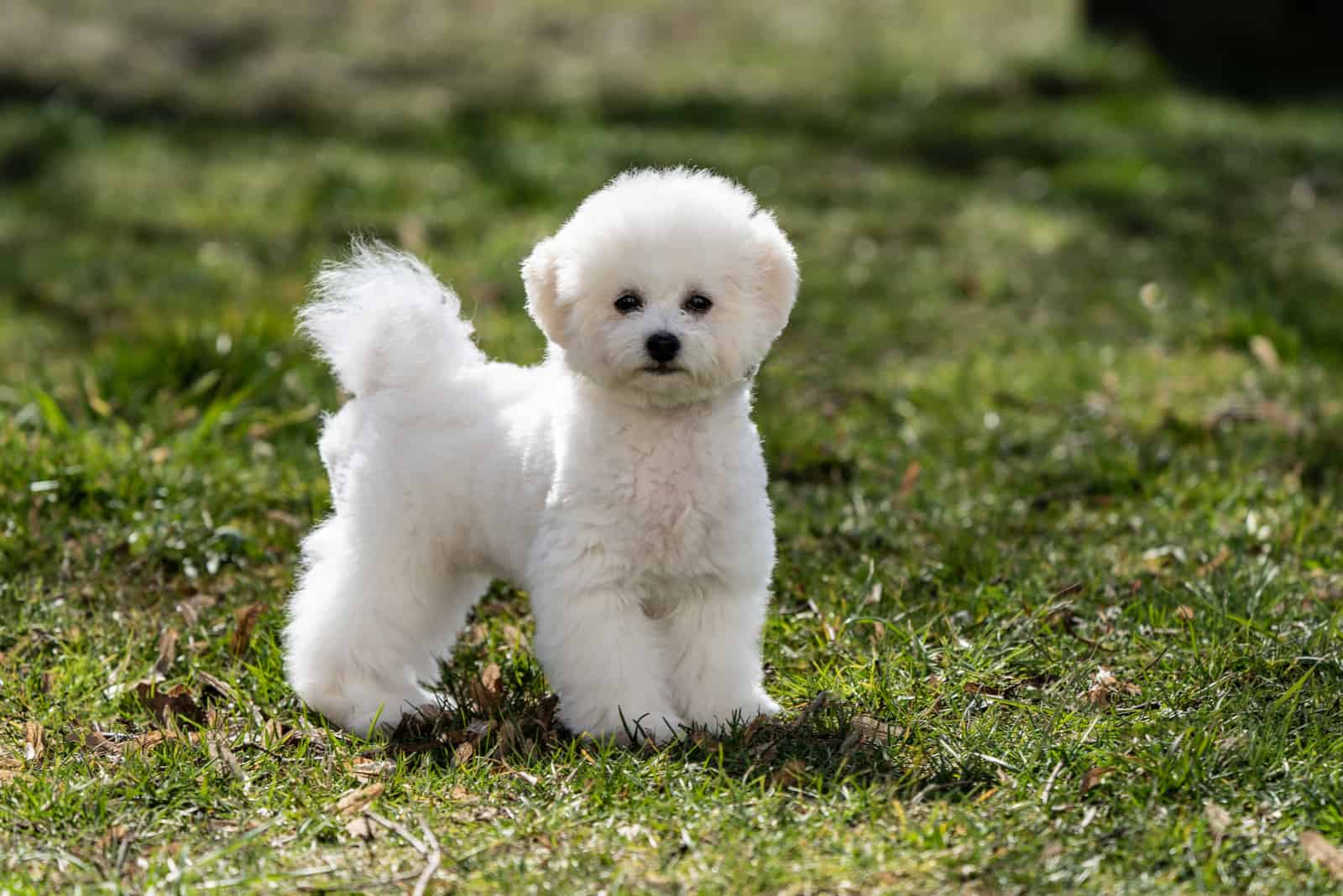
The Bichon Frise is best known for its solid white fur, but it can come with apricot, cream, and buff markings. But, what about other colors?
Pictures of brown and black Bichons can be found online. However, this isn’t a color that is naturally found in a Bichon’s genetics. Instead, these dogs are likely the product of crossbreeding with some other breeds – most likely, Poodles.
There are a few other Bichon Frise colors that you won’t be able to register within the AKC, and these dogs won’t be able to participate in conformation shows. All of these are the product of gene mixing to at least a certain amount.
Can A Bichon Frise Be Black?
Some breeders sell their ‘black and white’ Bichon Frise puppies, and there are certain pictures of all-black Bichons all over the internet.
However, Bichon Frises cannot come in black color or in any color that may be mistaken for black. If your doggy has black color on his fur, then he isn’t a Bichon Frise, but likely a Poochon – a Poodle Bichon Frise mix.
Can A Bichon Frise Be Brown?
On rare occasions, inexperienced dog breeders might try to sell you their ‘white and brown’ Bichon Frises. This doesn’t necessarily have to mean that their dogs aren’t purebred.
Some darker white and apricot or white and cream dogs might be mistaken for white and brown because of their brownish shade. However, they will still be either apricot or cream and not brown as their genetics are different. Also, these pups will always be primarily white.
Sometimes, you might see a Bichon Frise in the dog park that appears brown. Chances are there is a quite common explanation behind this: the dog is very dirty.
All-white dogs tend to get dirty extremely fast, and this can make them appear brown, especially if they rolled in the dirt or mud beforehand. Believe it or not, it can be hard to tell that this isn’t the color they’re born with!
If you happen to find a solid brown Bichon or a Bichon that is mostly brown, this isn’t a color that is recognized by the AKC. These dogs are most likely a hybrid breed.
Genetics Behind Bichon Frise Colors
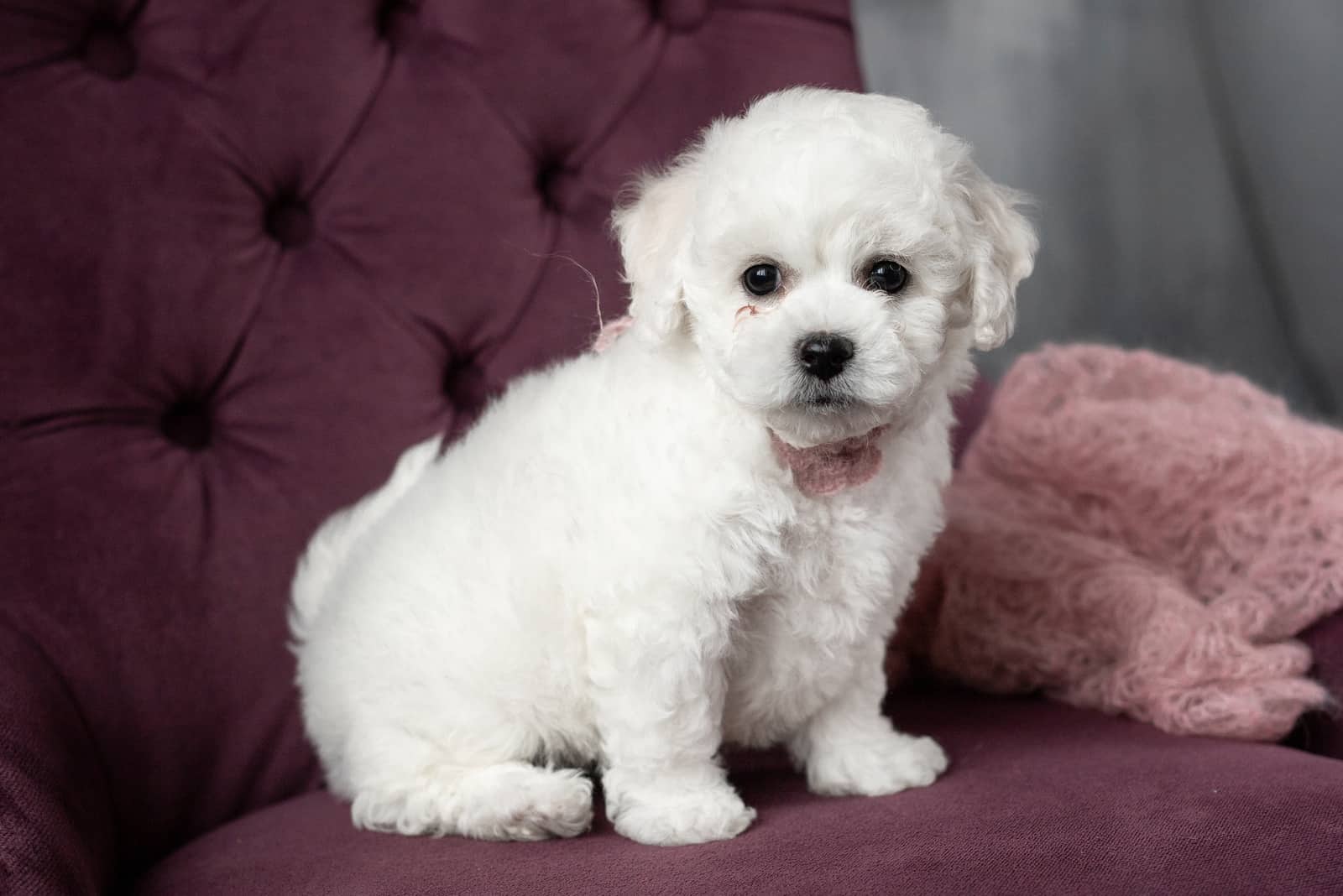
In all dog breeds, the coat color depends on genetics. Certain genes control not only the Bichon Frise colors, but also the pattern, or rather, the body areas where the color will appear.
Bichon Frise dogs are primarily white, which is usually the result of a lack of pigmentation. However, this family dog contains pheomelanin, a pigment responsible for yellow and red colors in dogs. This is why cream and apricot colors can occur in Bichon Frise dogs.
The largest portion of the pheomelanin in Bichons is diluted by a certain color gene, making it appear white. However, this dilution doesn’t necessarily affect the entire coat, which is why certain colored spots may occur.
Because there aren’t any other color genes in Bichon Frise dogs, if your pooch isn’t mainly white, or if it contains spots in a different color than the ones we’ve mentioned, then chances are they are mixed with some other breed.
The Rarest Bichon Frise Color
Out of all the accepted Bichon Frise colors, the rarest one is the white and buff mix. This is because buff is caused by a recessive gene, which means that it has to be present in both parent’s genetics in order to be inherited.
Also, not all dog shows accept the white and buff mix, making the buff shade somewhat undesirable, and not many breeders will willingly breed white and buff dogs. This further decreases the number of white and buff Bichons.
Keep in mind that the price of a Bichon Frise will be higher if a dog is in a rare color.
The Most Common Bichon Frise Color
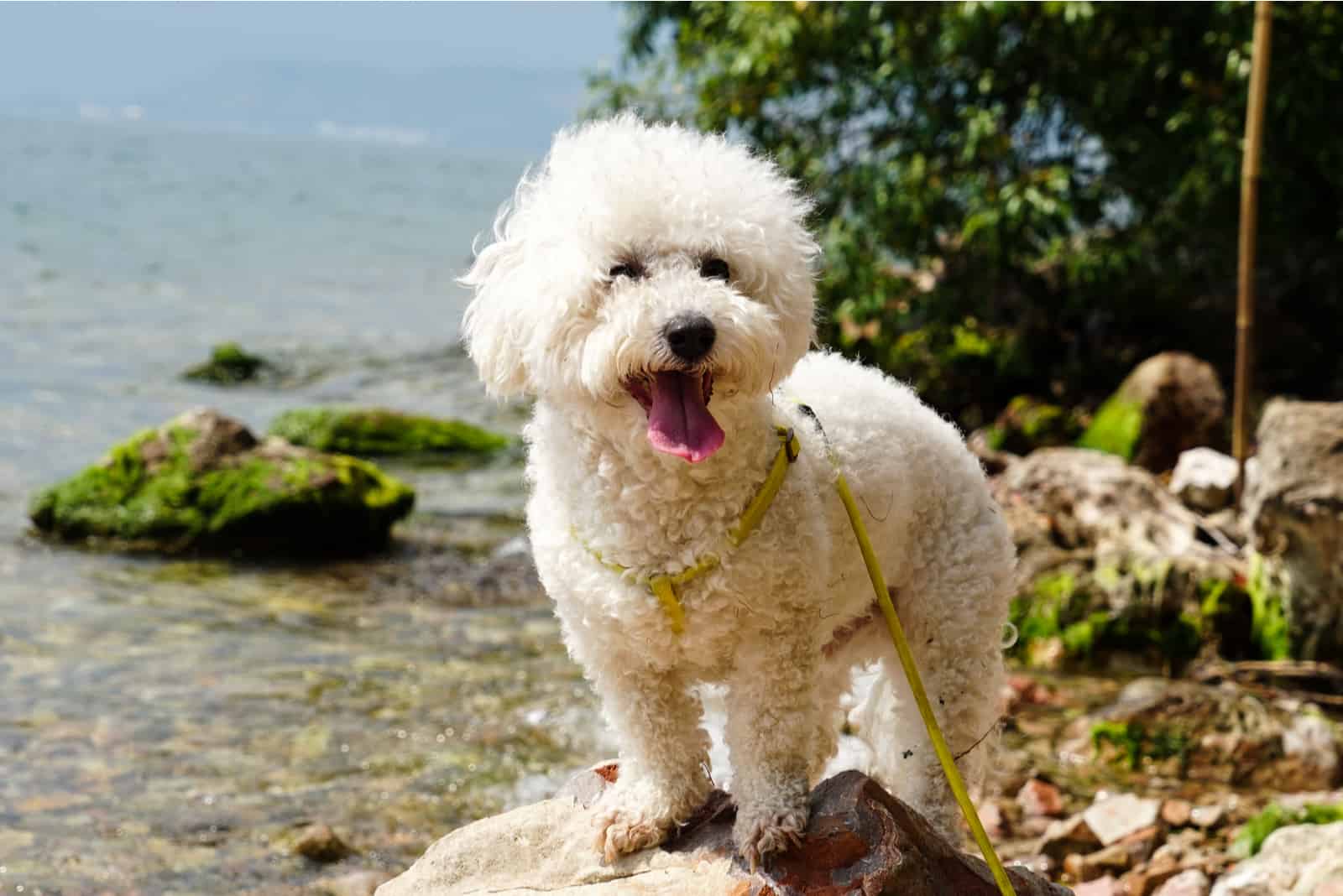
The answer to this isn’t even surprising. The most common color of the Bichon Frise is its most popular one, and the one these pups are known for, and that is all-white.
Bichons originally come in a white coat, so it’s no surprise that this is also its most common color. When most dog lovers plan on getting a Bichon, they want to get a white dog, and this is the color that most dog shows and kennel clubs prefer.
If you want a classic Bichon Frise, you need to get a dog that is entirely white. Of course, you are free to choose from any other standard color as all these dogs are adorable.
Bichon Frise Fur Changing Color
Some dog breeds tend to change the color of their fur over time. Can this happen to a Bichon Frise?
Many Bichon Frise puppies have buff, cream, and apricot shades on their fur. This is quite normal, and most of these dogs don’t stay bicolor for long. These markings will fade away over time, and the dog will become fully white by the time he is a year old.
Sometimes, these markings persist, and this is how you get other Bichon Frise colors. Keep in mind that most kennel clubs won’t accept dogs that have more than 10% of their coat in some other color than white.
Certain medical conditions may also cause a change in your Bichon Frise coat color. For example, some Bichon Frises might get red stains on their coat. This is caused by porphyrin, which are molecules containing iron that are found in your dog’s saliva, tears, and urine.
Brown stains are also possible, and these are usually caused by an ear infection called Malassezia, which might also cause skin and ear infections in a Bichon Frise.
If you notice any discoloration on your pooch’s fur, contact a local vet as soon as possible, so you can rule out any severe health problem.
And if you want to ensure your pup always has a healthy coat, make sure to feed him foods rich with omega-3 and omega-6 fatty acids, such as tuna or fish sticks.
Do Bichon Frises Have Albinism?
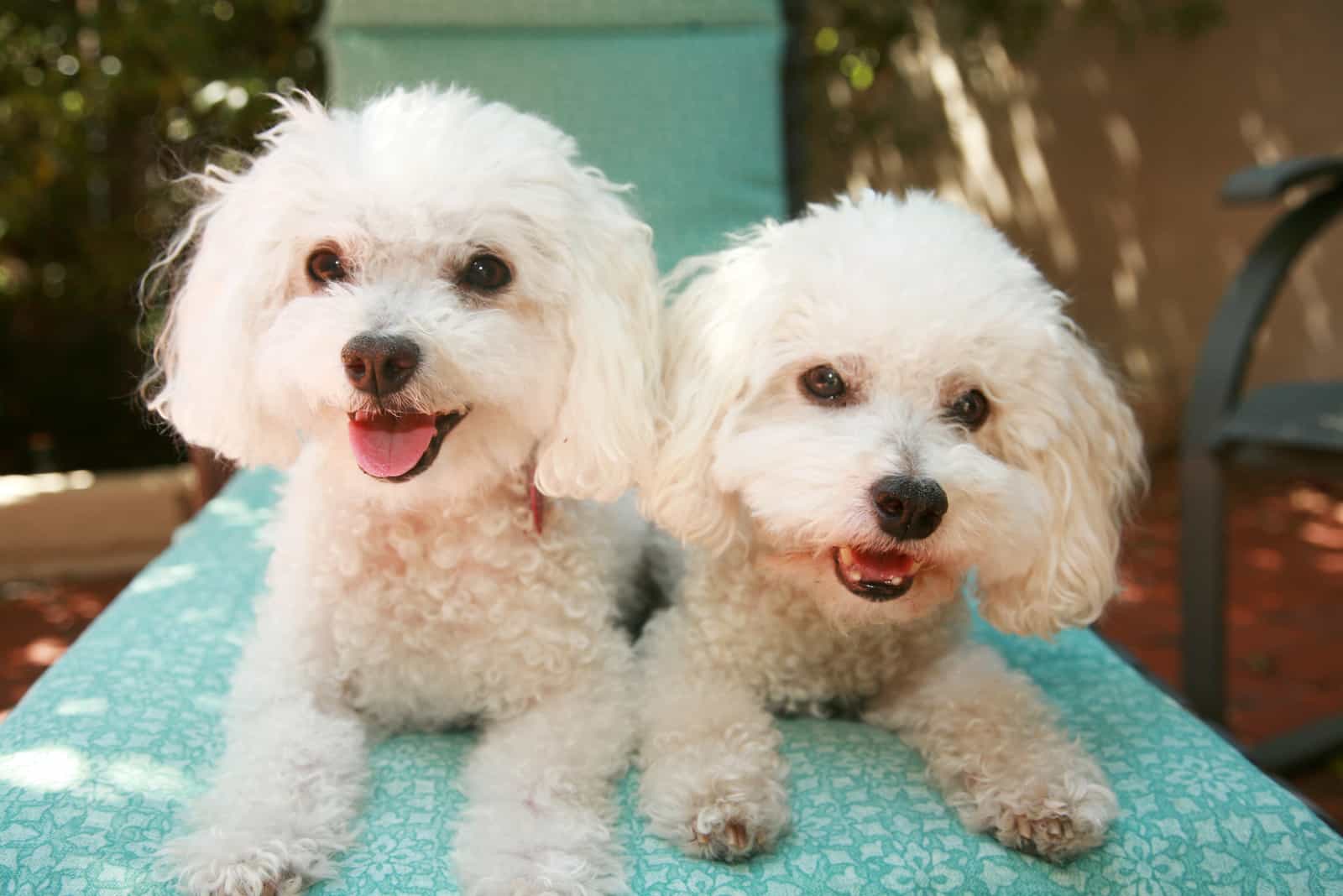
Despite them coming in white color, standard Bichon Frises don’t have albinism. As explained before, these powder puff dogs have a dilution gene that turns phaeomelanin into a white color.
Still, some Bichon Frises can suffer from albinism, just like this condition can be present in any other dog breed.
So, how can you determine an albino Bichon Frise from a standard Bichon Frise?
Bichon Frises have black noses and dark eyes that contrast their standard white color. This gives them that unique, toy-like appearance that many people love.
Once again, the reason behind this contrast lies in the dilution gene that affects the dog’s coat, but not the skin or eye color.
However, in albino dogs, the white coat isn’t the result of dilation, but rather, a lack of pigment. Albino Bichon Frises won’t have any pigment on their bodies! This means that their noses will be pink instead of black, and their eyes will be light in color. Sometimes, their blue eyes might have a reddish tint.
Albinism is a condition that doesn’t just affect Bichon Frise colors. It may also cause some health problems, such as eye defects, blindness, deafness, bone and heart issues, and even cancer. This is why the intentional breeding of albino Bichon Frises is frowned upon.
Fortunately, since Bichon Frises already come in white, not many people would even bother to reproduce dogs with this health condition just for the sake of color. Albinism is caused by a recessive gene, making it somewhat harder to spread on the offspring.
Does Coat Color Affect Bichon Frise Behavior?
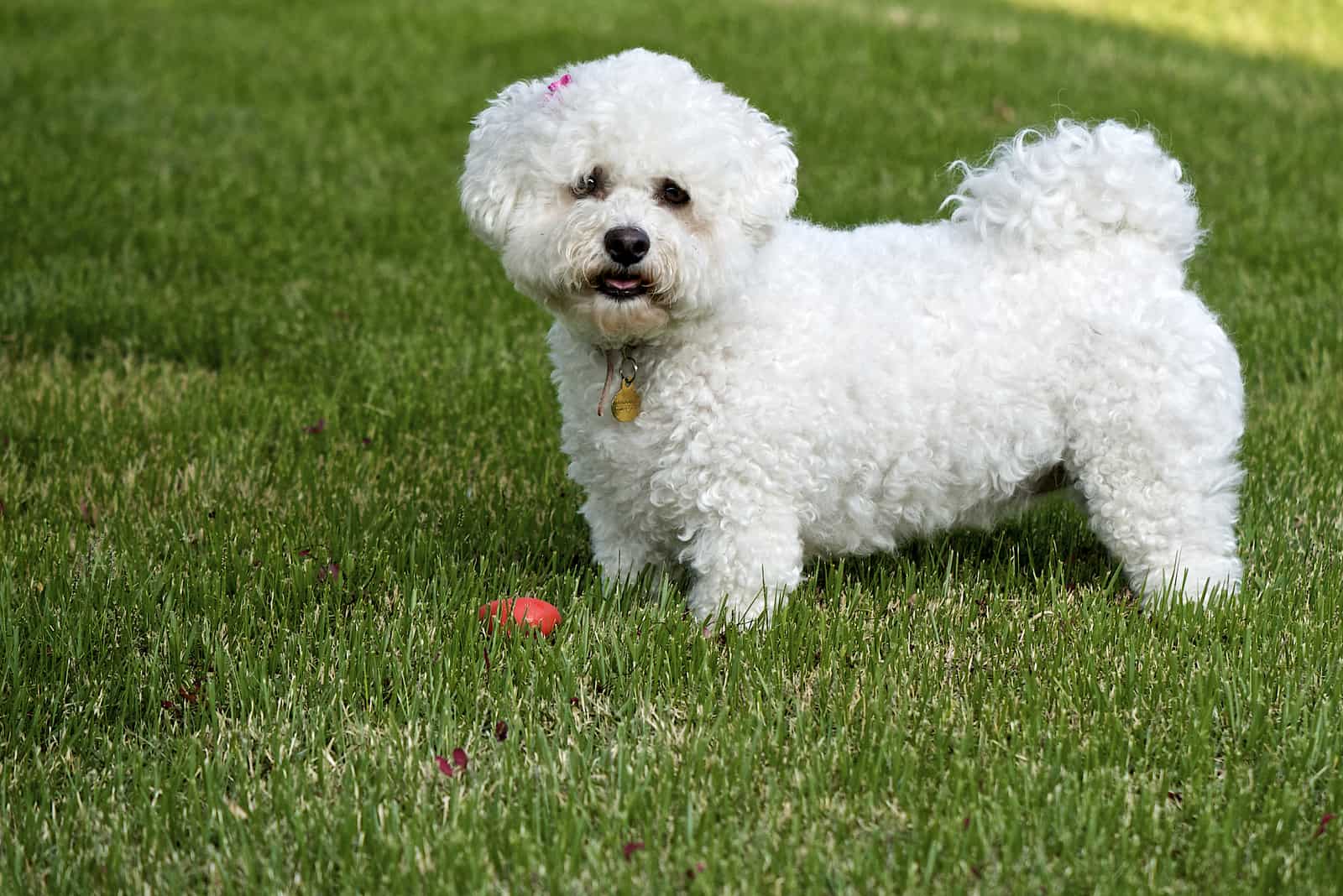
So far, there is no scientific confirmation that the coat color affects a dog’s behavior in any way. Even if it would, this wouldn’t affect Bichons in any way as these are primarily white dogs and no other colors can be found in a purebred dog.
However, the fact that there is a dilution gene present that turns their coat white does affect something, and that is a Bichon Frise’s health. Yes, there are some major health issues connected with the white coat color.
Some of these issues include:
Deafness
While it might not be obvious, dilution genes also affect a dog’s ears. On many occasions, nothing will happen. However, some dogs can become entirely deaf.
In fact, the Louisiana State University’s School of Veterinary Medicine found out that the Bichon Frise is among the dog breeds with the highest number of reported cases of deafness.
This isn’t new. Most white dogs are prone to hearing problems, and Bichons are just among many affected breeds.
Allergies
White dogs tend to have very sensitive skin. This can cause many skin problems, and they are more prone to irritations.
Another skin issue that Bichon Frises exhibit is allergies. These dogs have a high chance of developing allergies. However, this isn’t connected just with their skin. They are also prone to food allergies and can have many problems if their nutrition intake isn’t fully monitored.
In fact, Bichon Frises frequently suffer from tummy problems, and many dog foods can wreak havoc in their digestive system. In most cases, this will also reflect on their skin.
Cancer
Unfortunately, a Bichon Frise’s sensitive skin also makes these pups prone to skin cancer. There is a logical reason behind this.
Dogs with white coats and pale skin tend to sustain more sun damage than other dogs. If they get too much sun exposure, they’re likely to develop burns. The harmful effects of the sun can also make them develop skin cancer, which can be deadly.
Is A Bichon Frise Hypoallergenic?
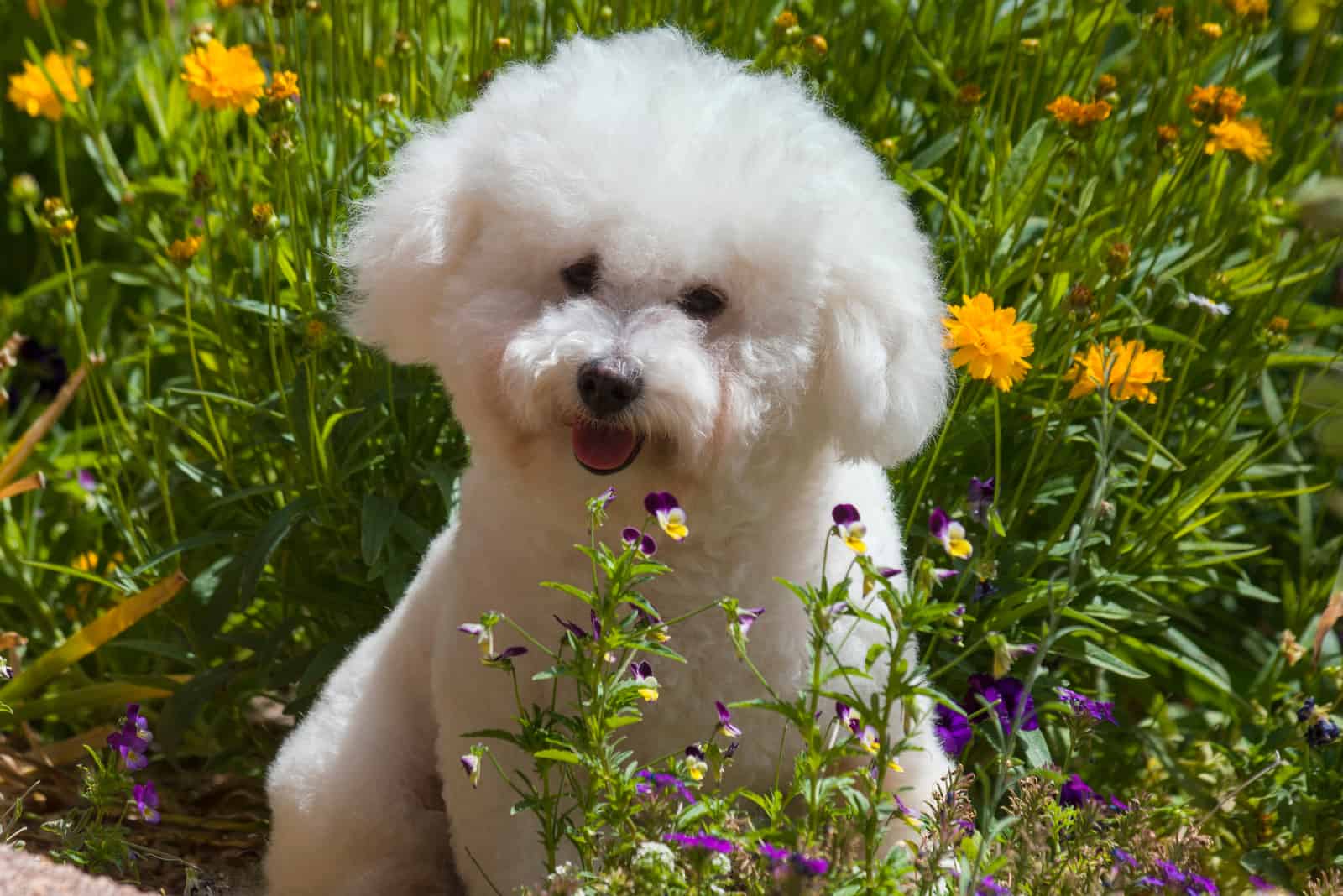
Other than gentle Bichon Frise colors, there is another reason why this dog breed is so popular, and that is their hypoallergenic coat.
Bichon Frises have a double coat with a short, thick undercoat and a longer, curly outercoat. While they do shed, just like any other dog breed, the loose hairs won’t fall off their body and fly around. Instead, they’ll get caught on the curls, staying where they are until you brush them or take them to the groomer.
While it isn’t the dog’s hair that’s causing you issues, but rather the dander, the allergens get caught on the hairs, and when the dog sheds, the dander gets spread everywhere. This is why you might think that you’re allergic to dog hair, while dander is the real culprit.
The allergens are also found in the dog’s saliva and urine. As a Bichon Frise is easy to potty train, and it doesn’t drool much, you can consider him the perfect hypoallergenic dog.
Keep in mind, though, that all dogs produce dander, saliva, and urine. This means that there is no dog that can be considered 100% hypoallergenic. However, a dog that doesn’t shed and doesn’t drool is very unlikely to cause issues even to a person with severe dog allergies.
Taking Care of a Bichon Frise’s Coat
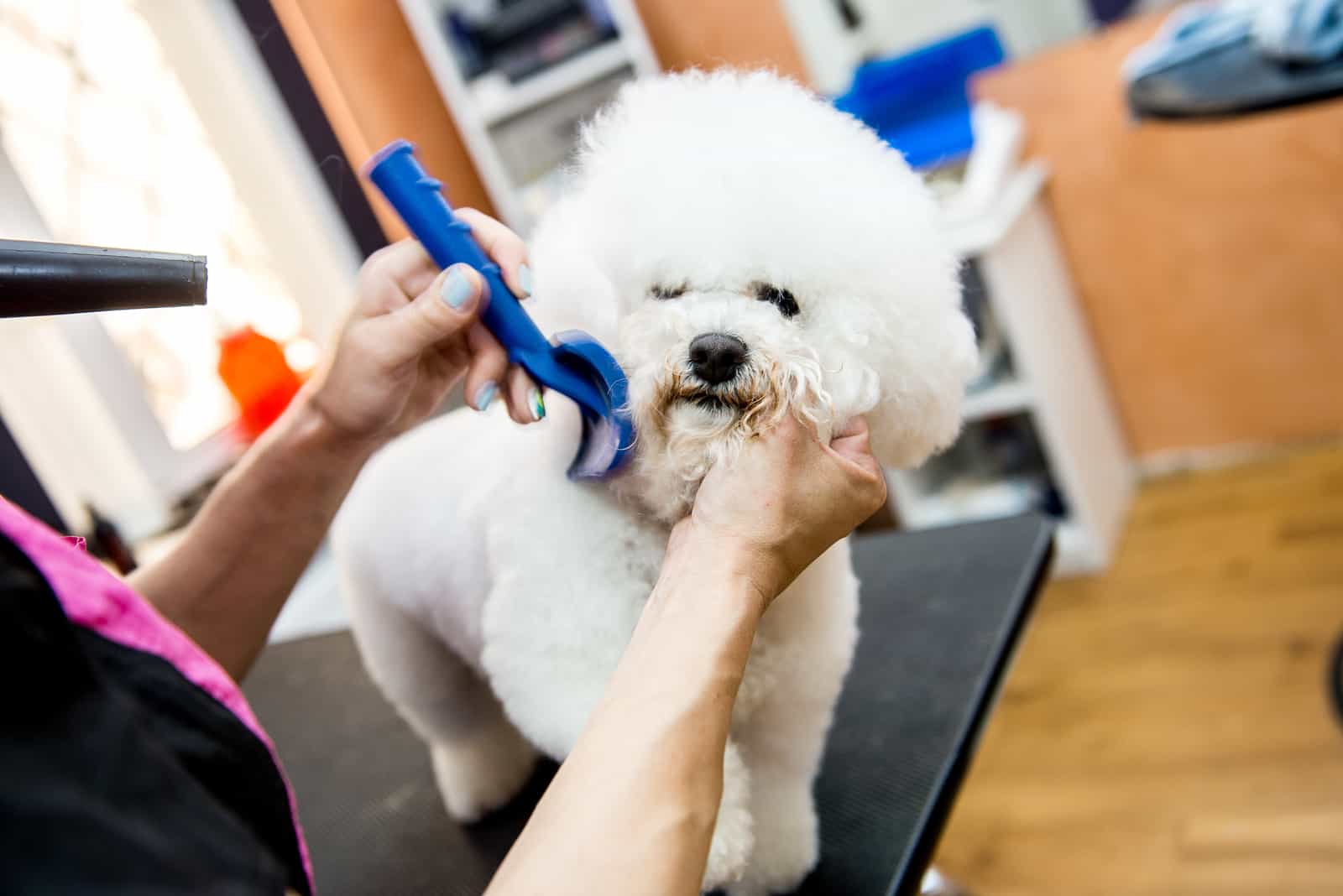
No matter what Bichon Frise colors you prefer, your new pooch will need some regular brushing and bathing to maintain its adorable appearance.
While Bichon Frises don’t shed, they are still somewhat challenging to take care of. This is because their curly coat keeps on growing continuously, so you need to take your pooch to the groomer on a regular basis. Otherwise, your Bichon Frise might develop mats and tangles.
A Bichon Frise coat that is well taken care of should be soft and coarse to the touch, but it shouldn’t have a silky or wiry feel to it. Instead, it should spring back into place after petting.
While coat trimming is necessary, you can choose whether you want to give him a signature Bichon Frise haircut or just keep him looking tidy.
The classic Bichon look means a slight pouf on the head, a defined mustache, and longer hairs on the dog’s beard and ears. The tail resembles a plume resting over the back.
Check some of the interesting Bichon Frise haircuts we listed that will make this pooch even more cute!
Daily brushing with a pin brush is necessary to remove any knots and keep the hairs from tangling. If you don’t brush your Bichon regularly, he might develop mats that can not only be difficult to remove, but also rather painful to your dog.
Some people prefer to have their Bichon’s coat entirely shaved, especially during the summer months. However, this isn’t recommended as it will expose the dog’s sensitive skin to sun damage.
We would recommend you leave bathing to a professional groomer. However, if you decide to do it yourself, brush his coat before getting him wet. If his coat happens to have mats, they’ll be nearly impossible to untangle once they are moist.
Never use human shampoo on any dog; this is especially important for a Bichon Frise. Harsh chemicals can irritate their sensitive skin, and this isn’t something you want.
Always blow-dry your Bichon Frise after a bath. Just remember to use the cool setting. Brush him with a slicker brush during the drying process.
Don’t forget to brush his teeth in order to remove plaque and lower the chances of developing some severe dental issues.
Also, check his ears to make sure they are odorless and without debris or redness. These small dogs are prone to ear infections, so you have to pay extra attention to them. Talk to your vet about dog ear plucking as well.
Bichon Frise Nose and Eye Colors
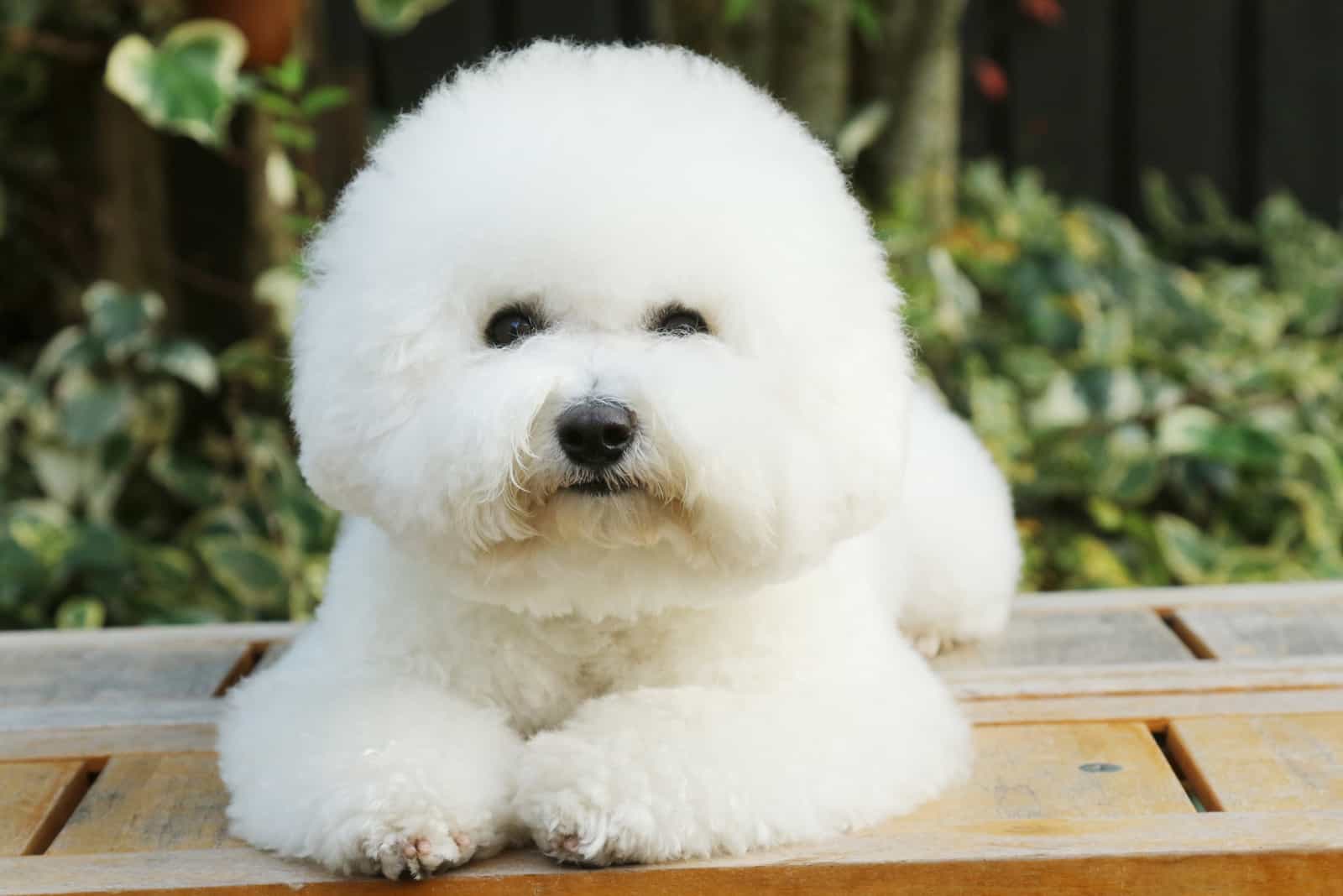
While talking about Bichon Frise colors, we have to mention their eye and nose colors.
Another thing that the breed is famous for is its deep brown or black eyes as well as its jet-black nose. However, not many people know that there are a few nose colors that these pups might have.
Sometimes, a Bichon Frise’s nose might have a liver or blue shade. He might also have a butterfly or Dudley nose.
A butterfly nose is when the Bichon has bright pink spots around its nose. Dudley noses are flesh-colored.
However, all kennel clubs demand that Bichons have a black nose and eyes as dark as possible. While noses in other colors don’t have to mean that a dog isn’t purebred, they are a disqualification for most dog shows.
Bichon Frise Nose Color Change
While the breed standard demands that Bichon Frises have a black nose, sometimes a Bichon’s nose color might change to pink. There are several reasons behind this:
• Genetics
• Cold weather
• Old age
• Infection
• Injury
• Disease
• Allergy
• Vitiligo
• Plastic bowl
Let’s get a bit more in-depth.
When it comes to genetics, a specific mutation in the TYRP 1 gene causes the Bichon Frise nose to turn pink. For a dog to have a pink nose, both parents need to be the carriers of the recessive gene causing the mutation.
A Bichon Frise might get a snow nose if he spends too much time in the cold. This condition is specific to white dogs, and causes the loss of pigment on the dog’s snout.
Fortunately, a snow nose is entirely harmless and it will only affect a dog’s appearance.
Sometimes, the black pigment tends to lose its efficiency as the dog grows old, making it paler in the shade as time goes by.
Nose injuries can scrape the upper layer of the skin off, making it appear pink until it heals. Most of the time, the pigment will return after some time passes, but if there is a scar, the portion of the nose might remain pink.
Some bacterial infections can cause irritation and redness, making the nose appear dark pink in color. This is usually followed by a crusty and unhealthy appearance.
Some diseases that might cause a Bichon Frise nose to become pink are pemphigus and discoid lupus.
Pemphigus is a skin disorder that begins in early middle age. It causes crusting of the skin, and while it can be painful, it’s entirely treatable.
On the other hand, discoid lupus is an autoimmune disease that cannot be healed, but it can be kept under control. It causes sores around the dog’s nose, discoloring it. This condition worsens after sun exposure.
Skin cancer is another disease that might cause your dog’s nose to change color. This happens when cancer causes the dog’s skin to be irritated and crusty, removing the black upper skin layers.
Allergies can also cause nose irritations, turning it bright pink or reddish.
Vitiligo is a progressive condition in which portions of the dog’s body and coat lose pigment. As Bichon Frises are naturally white dogs, this condition can only be visible on its nose, lips, and paw pads. Most of the time, it can give a dog a butterfly nose, but over time, the entire nose might turn pink.
Believe it or not, plastic bowls can also cause a dog’s nose to turn pink. This is because certain materials can cause irritations to the dog’s nose. On such occasions, the lips will also be affected. A good idea is to make sure your dog eats from a stainless steel bowl instead of plastic.
Does A Bichon Frise Have Black Skin?
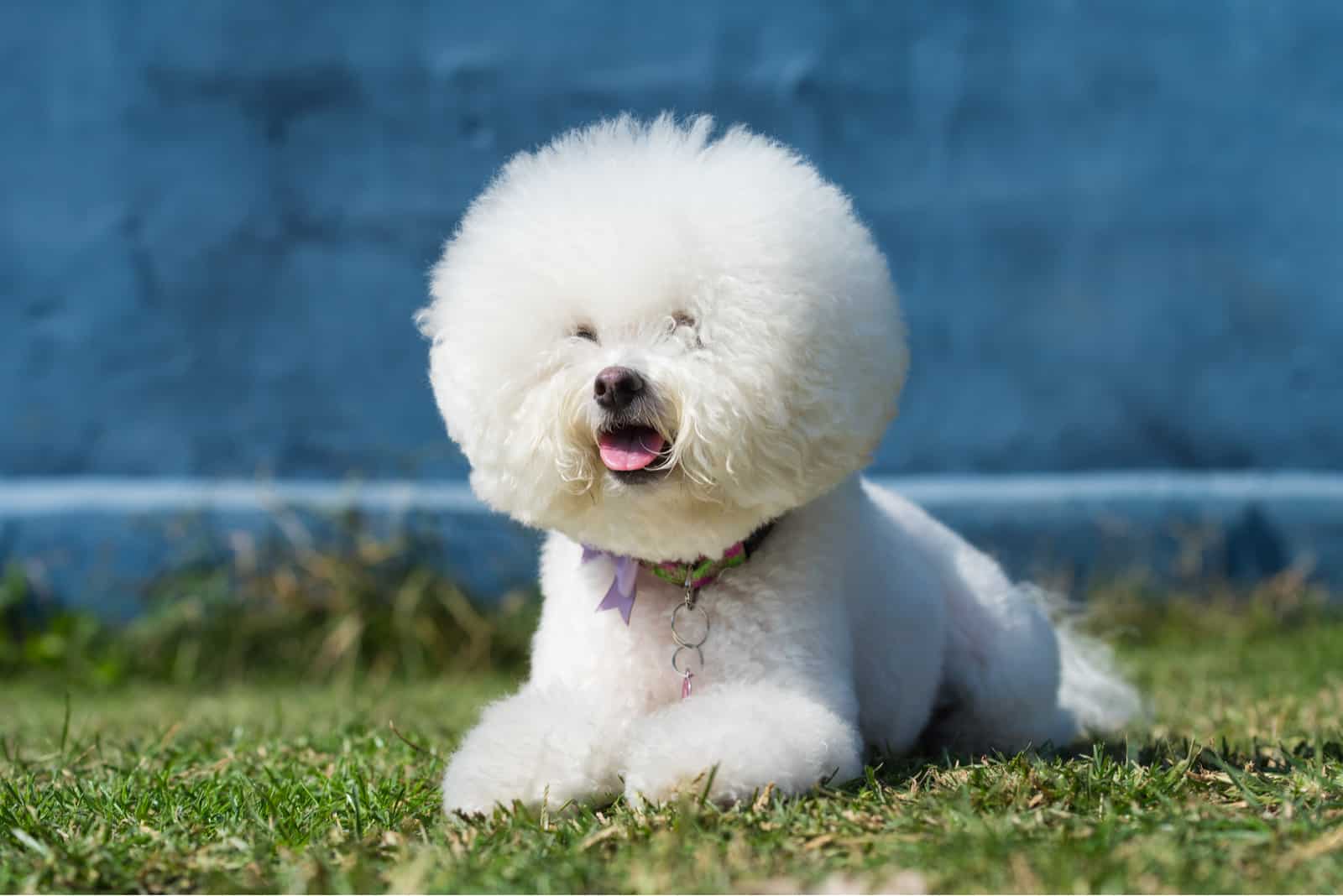
While now you know all about the Bichon Frise colors of the coat, you might wonder what is the color of the skin underneath all that white.
Since Bichon Frises have black noses and lips, many people believe that they also have black skin. However, this isn’t the case. A Bichon’s skin is usually pink in color. In fact, it is so light that you should keep your dog away from the sun.
However, a Bichon Frise might have darker patches on its light skin. These patches aren’t harmful – instead, many breeders find them desirable.
While there isn’t a known reason why these patches exist, you shouldn’t worry even if they weren’t there before. As long as your Bichon’s skin didn’t turn red or crusty, the development of black or dark brown patches is perfectly normal.
The Final Word
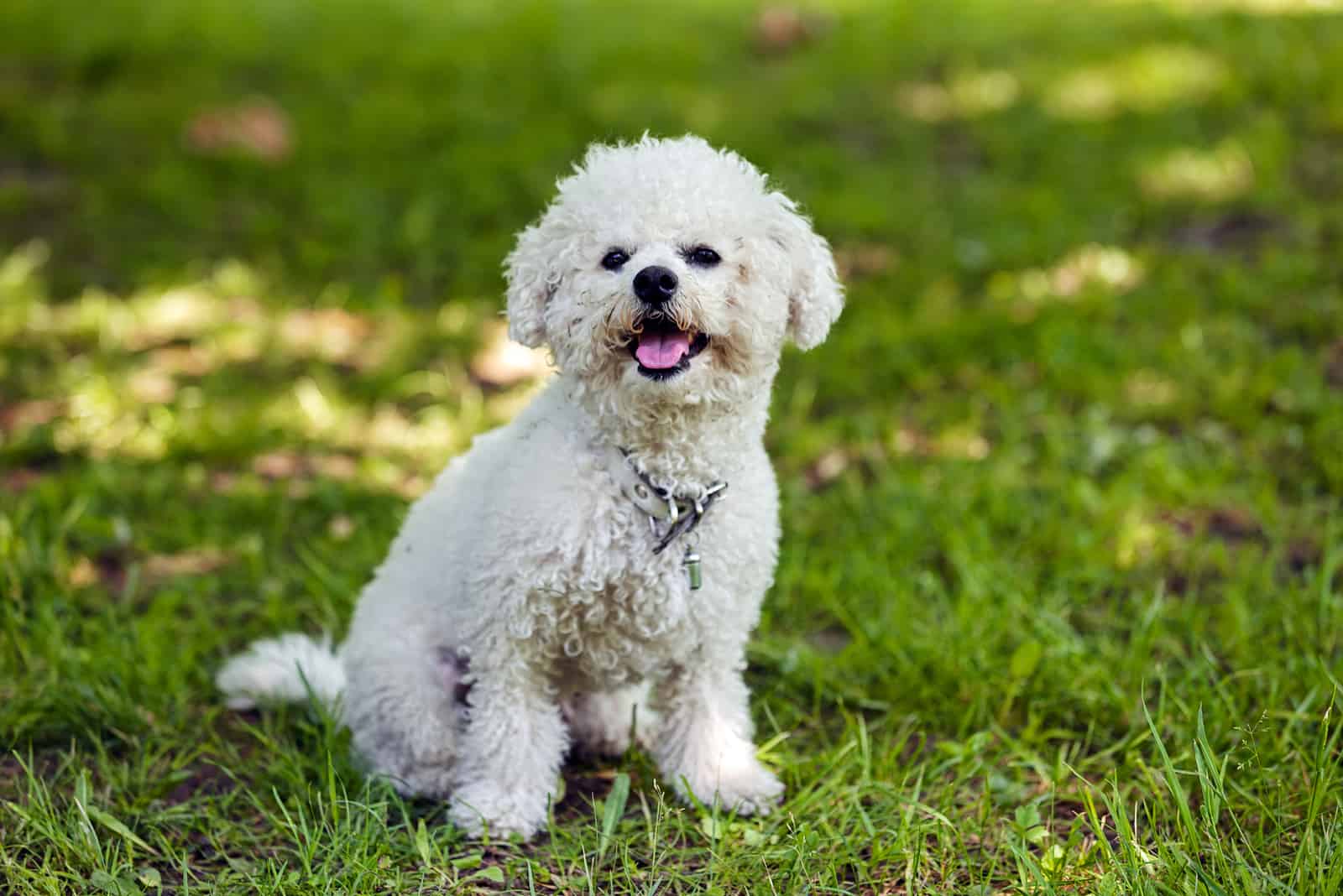
While you might think there are many rare Bichon Frise colors, this isn’t really the case with this dog breed. A purebred Bichon Frise should always be mostly white.
While black or brown variants seem appealing, these dogs aren’t true Bichons, but rather, crossbreeds. Don’t let the breeder tell you otherwise and make you spend a lot of money on a dog that likely won’t end up looking or behaving the way you think he will.
Bichon Frises are known for their glorious solid white coats, but having a few apricot, cream, or buff shades can give them a bit more of a unique appearance compared to a regular white coat. This is a good idea for any owner who wants to opt for a non-traditional look.
Even if you’re okay with purchasing a Bichon that isn’t purebred for the sake of a unique color, it isn’t a good idea to support deceitful breeders who are lying about the dogs being purebred but in a rare color. There are many official Bichon Frise cross breeds, and you can always try to find a dog that is the best match for you.
If you notice a sudden change in your Bichon Frise colors, it would be smart to contact your local vet. Changes in the color of both the nose and the coat can indicate some severe health problems and you shouldn’t take them lightly.
Read Next:
The 3 Best Bichon Frise Breeders In Ontario In 2022
8 Most Reputable Bichon Frise Breeders In The UK (2022)
